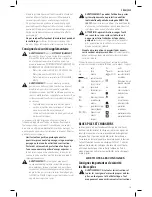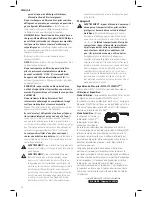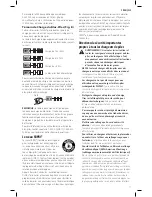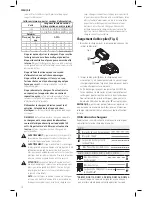
English
3
into account the working conditions and the
work to be performed.
Use of the power tool for
operations different from those intended could result
in a hazardous situation.
5) Battery Tool Use and Care
a )
Recharge only with the charger specified by the
manufacturer.
A charger that is suitable for one type
of battery pack may create a risk of fire when used
with another battery pack.
b )
Use power tools only with specifically designated
battery packs.
Use of any other battery packs may
create a risk of injury and fire.
c )
When battery pack is not in use, keep it away
from other metal objects, like paper clips, coins,
keys, nails, screws, or other small metal objects,
that can make a connection from one terminal to
another.
Shorting the battery terminals together may
cause burns or a fire.
d ) Under abusive conditions, liquid may be ejected from
the battery;
avoid contact. If contact accidentally
occurs, flush with water. If liquid contacts eyes,
additionally seek medical help.
Liquid ejected from
the battery may cause irritation or burns.
6) Service
a )
Have your power tool serviced by a qualified
repair person using only identical replacement
parts.
This will ensure that the safety of the power
tool is maintained.
Additional Safety Instructions for Rotary
Hammers
•
Wear ear protectors.
Exposure to noise can cause
hearing loss.
•
Use auxiliary handle(s), if supplied with the tool.
Loss
of control can cause personal injury.
•
Hold power tool by insulated gripping surfaces,
when performing an operation where the cutting
accessory may contact hidden wiring.
Cutting
accessory contacting a “live” wire may make exposed
metal parts of the power tool “live” and could give the
operator an electric shock.
•
Be certain that the material being drilled does
not conceal electric or gas service and that
their locations have been verified with the
utility companies.
•
Use clamps or other practical way to secure and
support the workpiece to a stable platform.
Holding
the work by hand or against your body is unstable and
may lead to loss of control.
•
Wear safety goggles or other eye protection.
Hammering operations cause chips to fly. Flying particles
can cause permanent eye damage. Wear a dust mask
or respirator for applications that generate dust. Ear
protection may be required for most applications.
•
Keep a firm grip on the tool at all times. Do not
attempt to operate this tool without holding it with
both hands.
Operating this tool with one hand will result
in loss of control. Breaking through or encountering hard
materials such as re-bar may be hazardous as well.
• Do not operate this tool for long periods of time. Vibration
caused by hammer action may be harmful to your hands
and arms. Use gloves to provide extra cushion and limit
exposure by taking frequent rest periods.
• Do not recondition bits yourself. Chisel reconditioning
should be done by an authorized specialist. Improperly
reconditioned chisels could cause injury.
• Accessories and tool may get hot during operation. Wear
gloves when handling them if performing heat producing
applications such as hammerdrilling and drilling metals.
• Never lay the tool down until the bit has come to a
complete stop. Moving bits could cause injury.
• Do not strike jammed bits with a hammer to dislodge
them. Fragments of metal or material chips could dislodge
and cause injury.
• Slightly worn chisels can be resharpened by grinding.
•
Do not overheat the bit (discoloration) while
grinding a new edge.
Badly worn chisels require
reforging. Do not reharden and temper the chisel.
Additional Safety Information
WARNING: ALWAYS
use safety glasses. Everyday
eyeglasses are NOT safety glasses. Also use face or
dust mask if cutting operation is dusty. ALWAYS WEAR
CERTIFIED SAFETY EQUIPMENT:
• ANSI Z87.1 eye protection (CAN/CSA Z94.3),
• ANSI S12.6 (S3.19) hearing protection,
• NIOSH/OSHA/MSHA respiratory protection.
WARNING:
Some dust created by power sanding,
sawing, grinding, drilling, and other construction
activities contains chemicals known to the State
of California to cause cancer, birth defects or
other reproductive harm. Some examples of these
chemicals are:
• lead from lead-based paints,
• crystalline silica from bricks and cement and other
masonry products, and
• arsenic and chromium from chemically-
treated lumber.
Your risk from these exposures varies, depending on how
often you do this type of work. To reduce your exposure to
these chemicals: work in a well ventilated area, and work with
approved safety equipment, such as those dust masks that are
specially designed to filter out microscopic particles.
•
Avoid prolonged contact with dust from power
sanding, sawing, grinding, drilling, and other
construction activities. Wear protective clothing and
wash exposed areas with soap and water.
Allowing
dust to get into your mouth, eyes, or lay on the skin may
promote absorption of harmful chemicals.
WARNING:
Use of this tool can generate and/
or disperse dust, which may cause serious and
permanent respiratory or other injury. Always use
NIOSH/OSHA approved respiratory protection




















